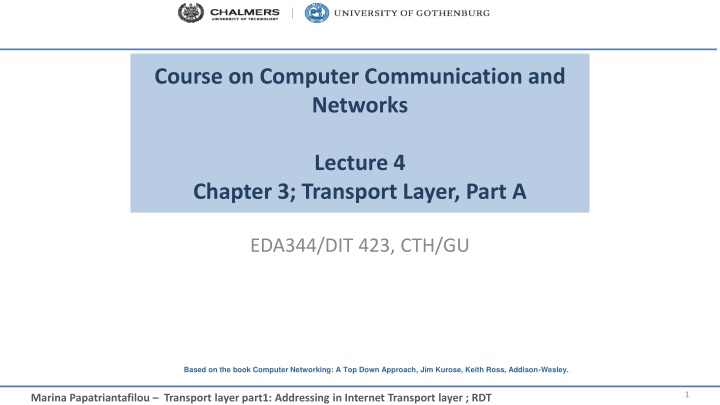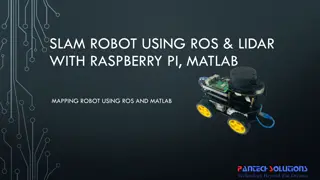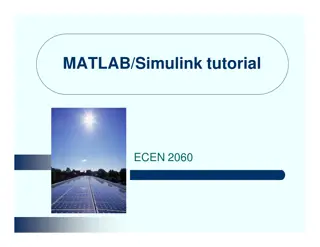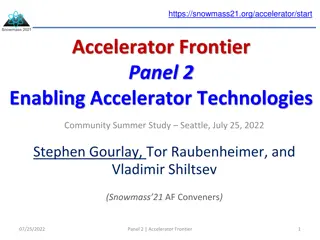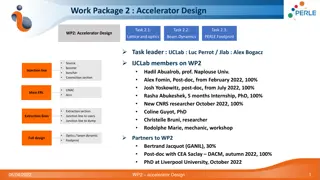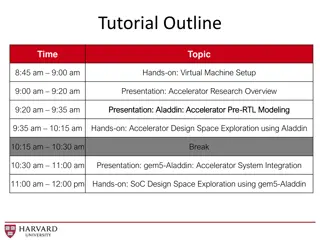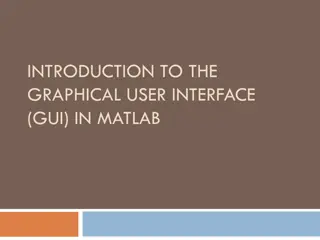Comparison of Matlab Middle Layer (MML) and Python Accelerator Middle Layer (pyAML)
Matlab Middle Layer (MML) developed in the 90s by SLAC and ALS, sits between high-level accelerator applications and low-level control systems. On the other hand, Python Accelerator Middle Layer (pyAML) is the Python equivalent of MML with various improvements, maintaining benefits like agnosticism, ease of use, and robust suite of applications. See how these two middle layers compare in the world of accelerator systems.
Download Presentation

Please find below an Image/Link to download the presentation.
The content on the website is provided AS IS for your information and personal use only. It may not be sold, licensed, or shared on other websites without obtaining consent from the author.If you encounter any issues during the download, it is possible that the publisher has removed the file from their server.
You are allowed to download the files provided on this website for personal or commercial use, subject to the condition that they are used lawfully. All files are the property of their respective owners.
The content on the website is provided AS IS for your information and personal use only. It may not be sold, licensed, or shared on other websites without obtaining consent from the author.
E N D
Presentation Transcript
Course on Computer Communication and Networks Lecture 4 Chapter 3; Transport Layer, Part A EDA344/DIT 423, CTH/GU Based on the book Computer Networking: A Top Down Approach, Jim Kurose, Keith Ross, Addison-Wesley. 1 Marina Papatriantafilou Transport layer part1: Addressing in Internet Transport layer ; RDT
Transport services and protocols application transport network data link physical provide communication services to app-layer protocols transport protocols run in end systems send side: breaks app messages into segments, passes to network layer application transport network data link physical rcv side: reassembles segments into messages, passes to app layer 2 Marina Papatriantafilou Transport layer part1: Addressing in Internet Transport layer ; RDT
Parenthesis: On last weeks questions Q: Types of services that a transport layer may need to provide. Which of those are provided by in the Internet transport layer protocols? Services i.e. properties No-loss In-order delivery Timeliness i.e. latency, bandwidth guarantees 3 Marina Papatriantafilou Transport layer part1: Addressing in Internet Transport layer ; RDT
Internet transport-layer protocols Reliable, in-order delivery: TCP also provides connection setup flow control + care for the health of the network (aka TCP s congestion control) application transport network data link physical Recall: best-effort datagram service network data link physical network data link physical network data link physical Best effort (can be unreliable, unordered) delivery: UDP no-frills extension of best-effort IP network data link physical network data link physical network data link physical Both support addressing (encapsulation), of course! application transport network data link physical network data link physical Transport Layer services not available in the Internet: Delay/bandwidth guarantees. Why? When the (successful due to simplicity) TCP/IP protocol stack was defined, no foreseeable need for such applications in an inter-net. 4 Marina Papatriantafilou Transport layer part1: Addressing in Internet Transport layer ; RDT
Roadmap Transport layer services in Internet Addressing, multiplexing/demultiplexing Connectionless, unreliable transport: UDP Principles of reliable data transfer Next lecture: connection-oriented transport: TCP reliable transfer flow control connection management TCP congestion control 5 Marina Papatriantafilou Transport layer part1: Addressing in Internet Transport layer ; RDT
Addressing: Multiplexing/demultiplexing (+ recall encapsulation) Multiplexing at send host: Demultiplexing at rcv host: gathering data, enveloping data with header (later used for demultiplexing) delivering received segments to correct socket = socket = process P4 application P1 P1 P2 P3 application application transport transport transport network network network link link link physical physical physical host 3 host 2 host 1 Recall: segment - unit of data exchanged between transport layer entities aka TPDU: transport protocol data unit 6 Marina Papatriantafilou Transport layer part1: Addressing in Internet Transport layer ; RDT
Addressing Host receives IP datagrams Datagram (i.e. IP packet) has source IP address, destination IP address datagram carries transport-layer segment segment has source, destination port number Host uses IP addresses & port numbers to direct segment to appropriate socket 32 bits source port # dest port # other header fields application data (payload) TCP/UDP segment format 7 Marina Papatriantafilou Transport layer part1: Addressing in Internet Transport layer ; RDT
UDP addressing demultiplexing + example IP datagrams with same dest. port # (but perhaps different source IP addresses or source port numbers will be directed) to the same socket when host receives UDP segment: directs UDP segment to socket with that port # DatagramSocket serverSocket = new DatagramSocket (6428); application DatagramSocket mySocket2 = new DatagramSocket (9157); DatagramSocket mySocket1 = new DatagramSocket (5775); application P4 application P3 P1 transport transport transport network network network link link link physical physical physical source port: 6428 dest port: 9157 source port: ? dest port: ? source port: ? dest port: ? source port: 9157 dest port: 6428 8 Marina Papatriantafilou Transport layer part1: Addressing in Internet Transport layer ; RDT
TCPConnection-oriented (TCP) addressing/demux + example TCP socket identified by 4-tuple: source IP address, source port number dest IP address, dest port number (Demux) Receiver uses all 4 values to direct segment to appropriate socket application P4 application P2 application P3 P5 P6 P3 transport transport transport network network network link link link physical physical physical server: IP address B client: IP address C source IP,port: B,80 dest IP,port: A,9157 client: IP address A source IP,port: C,5775 dest IP,port: B,80 source IP,port: A,9157 dest IP, port: B,80 source IP,port: C,9157 dest IP,port: B,80 9 Marina Papatriantafilou Transport layer part1: Addressing in Internet Transport layer ; RDT
TCP demux: Threaded web server threaded server application P4 application P2 application P3 P3 transport transport transport network network network link link link physical physical physical server: IP address B host: IP address C source IP,port: B,80 dest IP,port: A,9157 host: IP address A source IP,port: C,5775 dest IP,port: B,80 source IP,port: A,9157 dest IP, port: B,80 source IP,port: C,9157 dest IP,port: B,80 10 Marina Papatriantafilou Transport layer part1: Addressing in Internet Transport layer ; RDT
Roadmap Transport layer services Addressing, multiplexing/demultiplexing Connectionless, unreliable transport: UDP principles of reliable data transfer Next lecture: connection-oriented transport: TCP reliable transfer flow control connection management TCP congestion control 11 Marina Papatriantafilou Transport layer part1: Addressing in Internet Transport layer ; RDT
UDP: User Datagram Protocol [RFC 768] best effort service, UDP segments may be: lost delivered out-of-order connectionless: no handshaking between UDP sender, receiver each UDP segment handled independently of others 12 Marina Papatriantafilou Transport layer part1: Addressing in Internet Transport layer ; RDT
UDP: segment header length, in bytes of UDP datagram, including header 32 bits source port # dest port # checksum length why is there a UDP? Must do the addressing job no connection establishment (which could add delay) simple: no connection state at sender, receiver small header size no congestion control: UDP can blast away segments faster (than TCP) application data (payload) UDP datagram format 13 Marina Papatriantafilou Transport layer part1: Addressing in Internet Transport layer ; RDT
UDP Checksum[RFC 1071]: check bit flips Sender: treat segment contents as sequence of 16-bit integers checksum: addition (1 s complement sum) of segment contents sender puts checksum value into UDP checksum field Receiver: compute checksum of received segment check if computed checksum == checksum field value: NO - error detected (report error to app or discard) YES - no error detected. But maybe (rarely) errors nonetheless? More later . 1 1 1 1 0 0 1 1 0 0 1 1 0 0 1 1 0 1 1 1 0 1 0 1 0 1 0 1 0 1 0 1 0 1 Wraparound: Add to final 1 1 0 1 1 1 0 1 1 1 0 1 1 1 0 1 1 sum 1 1 0 1 1 1 0 1 1 1 0 1 1 1 1 0 0 1 0 1 0 0 0 1 0 0 0 1 0 0 0 0 1 1 checksum 14 Marina Papatriantafilou Transport layer part1: Addressing in Internet Transport layer ; RDT
Roadmap Transport layer services Addressing, multiplexing/demultiplexing Connectionless, unreliable transport: UDP principles of reliable data transfer Next lecture: connection-oriented transport: TCP reliable transfer flow control connection management TCP congestion control 15 Marina Papatriantafilou Transport layer part1: Addressing in Internet Transport layer ; RDT
Principles of reliable data transfer top-10 list of important networking topics! characteristics of unreliable channel will determine complexity of reliable data transfer protocol (rdt) 16 Marina Papatriantafilou Transport layer part1: Addressing in Internet Transport layer ; RDT
Reliable data transfer (RDT): getting started rdt_send(): called from above, (e.g., by app.). Passed data to deliver to receiver upper layer deliver_data(): called by rdt to deliver data to upper send side receive side udt_send(): called by rdt, to transfer packet over unreliable channel to receiver rdt_rcv(): called when packet arrives on rcv-side of channel 17 Marina Papatriantafilou Transport layer part1: Addressing in Internet Transport layer ; RDT
RDT: S application: Author Writes and Sends pages R application: publisher Receives & publishes written pages S transport: secretary Alice Must send pages on behalf of author S transport: secretary Bob Receives pages; Must pass on to publisher in-order Bidirectional 1-page-at-a-time-MMS connection A sends one page at a time; How do A & B do their job if MMS connection is reliable? might introduce errors? might lose MMSs? 18 Marina Papatriantafilou Transport layer part1: Addressing in Internet Transport layer ; RDT
Reliable data transfer: getting started We will: incrementally develop sender, receiver sides of reliable data transfer protocol (rdt) use finite state machines (FSM) to specify sender, receiver behaviour event causing state transition actions taken on state transition state: when in this state next state uniquely determined by next state 1 state 2 event actions event 19 Marina Papatriantafilou Transport layer part1: Addressing in Internet Transport layer ; RDT
rdt1.0: reliable transfer & reliable channel underlying channel perfectly reliable no bit errors, no loss of packets separate FSMs for sender, receiver: rdt_send(data) rdt_rcv(packet) Wait for call from below Wait for call from above extract (packet,data) deliver_data(data) packet = make_pkt(data) udt_send(packet) receiver sender 20 Marina Papatriantafilou Transport layer part1: Addressing in Internet Transport layer ; RDT
rdt2.0: channel with bit errors underlying channel may flip bits in packet checksum to detect bit errors how to recover from errors: acknowledgements (ACKs): receiver explicitly tells sender that pkt received OK negative acknowledgements (NAKs): receiver explicitly tells sender that pkt had errors sender retransmits pkt on receipt of NAK New mechanisms in rdt2.0 (beyond rdt1.0): error detection feedback: control msgs (ACK,NAK) from receiver to sender 21 Marina Papatriantafilou Transport layer part1: Addressing in Internet Transport layer ; RDT
rdt2.0: FSM specification rdt_send(data) receiver sndpkt = make_pkt(data, checksum) udt_send(sndpkt) rdt_rcv(rcvpkt) && isNAK(rcvpkt) Wait for call from above Wait for ACK or NAK rdt_rcv(rcvpkt) && corrupt(rcvpkt) udt_send(sndpkt) udt_send(NAK) rdt_rcv(rcvpkt) && isACK(rcvpkt) Wait for call from below sender rdt_rcv(rcvpkt) && notcorrupt(rcvpkt) extract(rcvpkt,data) deliver_data(data) udt_send(ACK) 22 Marina Papatriantafilou Transport layer part1: Addressing in Internet Transport layer ; RDT
rdt2.0: operation with no errors rdt_send(data) snkpkt = make_pkt(data, checksum) udt_send(sndpkt) rdt_rcv(rcvpkt) && isNAK(rcvpkt) Wait for call from above Wait for ACK or NAK rdt_rcv(rcvpkt) && corrupt(rcvpkt) udt_send(sndpkt) udt_send(NAK) rdt_rcv(rcvpkt) && isACK(rcvpkt) Wait for call from below rdt_rcv(rcvpkt) && notcorrupt(rcvpkt) extract(rcvpkt,data) deliver_data(data) udt_send(ACK) 23 Marina Papatriantafilou Transport layer part1: Addressing in Internet Transport layer ; RDT
rdt2.0: error scenario rdt_send(data) snkpkt = make_pkt(data, checksum) udt_send(sndpkt) rdt_rcv(rcvpkt) && isNAK(rcvpkt) Wait for call from above Wait for ACK or NAK rdt_rcv(rcvpkt) && corrupt(rcvpkt) udt_send(sndpkt) udt_send(NAK) rdt_rcv(rcvpkt) && isACK(rcvpkt) Wait for call from below rdt_rcv(rcvpkt) && notcorrupt(rcvpkt) extract(rcvpkt,data) deliver_data(data) udt_send(ACK) 24 Marina Papatriantafilou Transport layer part1: Addressing in Internet Transport layer ; RDT
Recall: RDT (Reliable Data Transfer, aka error control) S application: Author Writes and Sends pages R application: publisher Receives & publishes written pages S transport: secretary Alice Must send pages on behalf of author S transport: secretary Bob Receives pages; Must pass on to publisher in-order Bidirectional 1-page-at-a-time-MMS connection A sends one page at a time; How do A & B do their job if MMS connection is reliable? might introduce errors? might lose MMSs? 25 Marina Papatriantafilou Transport layer part1: Addressing in Internet Transport layer ; RDT
rdt3.0: channels with errors and loss We saw: how ack+retransmit can solve problems with errors New assumption: underlying channel can also lose packets (data, ACKs) approach: sender waits reasonable amount of time for ACK retransmits if no ACK received in this time requires countdown timer 26 Marina Papatriantafilou Transport layer part1: Addressing in Internet Transport layer ; RDT
Recall: RDT (Reliable Data Transfer, aka error control) S application: Author Writes and Sends pages R application: publisher Receives & publishes written pages S transport: secretary Alice Must send pages on behalf of author S transport: secretary Bob Receives pages; Must pass on to publisher in-order Bidirectional 1-page-at-a-time-MMS connection A sends one page at a time; How do A & B do their job if MMS connection is reliable? might introduce errors? might lose MMSs? (lost vs too late MMS?) 27 Marina Papatriantafilou Transport layer part1: Addressing in Internet Transport layer ; RDT
rdt3.0 (cont) : channels with errors and loss We saw: how ack+retransmit can solve problems with errors New assumption: underlying channel can also lose packets (data, ACKs) approach: sender waits reasonable amount of time for ACK retransmits if no ACK received in this time requires countdown timer if pkt (or ACK) just delayed (not lost): Must handle duplicates -> 3-28 Marina Papatriantafilou Transport layer part1: Addressing in Internet Transport layer ; RDT
rdt3.0 in action receiver sender receiver sender send pkt0 send pkt0 pkt0 pkt0 rcv pkt0 rcv pkt0 send ack0 send ack0 ack0 ack0 rcv ack0 send pkt1 rcv ack0 send pkt1 pkt1 pkt1 X rcv pkt1 send ack1 loss ack1 rcv ack1 pkt0 send pkt0 timeout resend pkt1 rcv pkt0 send ack0 pkt1 ack0 rcv pkt1 send ack1 ack1 rcv ack1 pkt0 send pkt0 rcv pkt0 send ack0 (a) no loss ack0 (b) packet loss 29 Marina Papatriantafilou Transport layer part1: Addressing in Internet Transport layer ; RDT
rdt3.0 in action receiver sender receiver sender send pkt0 pkt0 rcv pkt0 send pkt0 pkt0 send ack0 ack0 rcv pkt0 rcv ack0 send pkt1 send ack0 ack0 pkt1 rcv ack0 send pkt1 rcv pkt1 send ack1 pkt1 rcv pkt1 send ack1 ack1 ack1 X loss timeout resend pkt1 rcv ack1 pkt1 rcv pkt1 timeout resend pkt1 pkt1 (detect duplicate) send ack1 rcv pkt0 send ack0 rcv pkt0 (detect duplicate) pkt0 rcv pkt1 send pkt0 (detect duplicate) send ack1 ack1 ack1 rcv ack1 ack0 rcv ack1 send pkt0 pkt0 pkt0 send pkt0 rcv pkt0 send ack0 ack0 ack0 send ack0 (d) premature timeout/ delayed ACK (c) ACK loss 30 Marina Papatriantafilou Transport layer part1: Addressing in Internet Transport layer ; RDT
Roadmap Transport layer services in Internet Addressing, multiplexing/demultiplexing Connectionless, unreliable transport: UDP principles of reliable data transfer Efficiency perspective Next lecture: connection-oriented transport: TCP reliable transfer flow control connection management TCP congestion control 31 Marina Papatriantafilou Transport layer part1: Addressing in Internet Transport layer ; RDT
Performance of rdt3.0 (stop&wait) rdt3.0 is correct, but performance stinks e.g.: 1 Gbps channel, 15 ms prop. delay, 8000 (1KB) bit packet: Dtrans=L 8000 bits 109 bits/sec = 8 microsecs = R sender receiver first packet bit arrives last packet bit arrives, send ACK RTT ACK arrives, send next packet, t = RTT + L / R 32 Marina Papatriantafilou Transport layer part1: Addressing in Internet Transport layer ; RDT
Performance of rdt3.0 (cont) Utilization (fraction of time sender busy sending, or fraction of utilized bandwidth ): L / R .008 30.008 U sender = = 0.00027 = RTT + L / R Ie approx. 300 kbps effective throughput over a 1 Gbps channel network protocol limits use of physical resources! 33 Marina Papatriantafilou Transport layer part1: Addressing in Internet Transport layer ; RDT
Is RDT necessarily that slow/inefficient? 34 Marina Papatriantafilou Transport layer part1: Addressing in Internet Transport layer ; RDT
Pipelined protocols pipelining: sender allows multiple, in-flight , yet-to-be-acknowledged pkts range of sequence numbers must be increased buffering at sender and/or receiver 35 Marina Papatriantafilou Transport layer part1: Addressing in Internet Transport layer ; RDT
Pipelining: increased utilization sender receiver first packet bit transmitted, t = 0 last bit transmitted, t = L / R first packet bit arrives last packet bit arrives, send ACK last bit of 2ndpacket arrives, send ACK last bit of 3rdpacket arrives, send ACK RTT ACK arrives, send next packet, t = RTT + L / R 3-packet pipelining increases utilization by a factor of 3! 3L / R RTT + L / R .0024 30.008 U sender = = 0.00081 = 36 Marina Papatriantafilou Transport layer part1: Addressing in Internet Transport layer ; RDT
Pipelined protocols: ack-based error control if data is lost, two generic forms of pipelined protocols: go-Back-n, selective repeat 37 Marina Papatriantafilou Transport layer part1: Addressing in Internet Transport layer ; RDT
Go-Back-n: sender window of up to N, consecutive unack ed pkts allowed ACK(n): ACKs all pkts up to, including seq # n - cumulative ACK may receive duplicate ACKs timer for oldest in-flight pkt timeout(n): retransmit packet n and all higher seq # pkts in window 38 Marina Papatriantafilou Transport layer part1: Addressing in Internet Transport layer ; RDT
https://media.pearsoncmg.com/aw/ecs_kurose_compnetwork_7/cw /content/interactiveanimations/go-back-n-protocol/index.html GBn in action sender receiver sender window (N=4) send pkt0 send pkt1 send pkt2 send pkt3 (wait) 0 1 2 3 4 5 6 7 8 0 1 2 3 4 5 6 7 8 0 1 2 3 4 5 6 7 8 0 1 2 3 4 5 6 7 8 receive pkt0, send ack0 receive pkt1, send ack1 Xloss receive pkt3, discard, (re)send ack1 rcv ack0, send pkt4 rcv ack1, send pkt5 0 1 2 3 4 5 6 7 8 0 1 2 3 4 5 6 7 8 receive pkt4, discard, (re)send ack1 receive pkt5, discard, (re)send ack1 ignore duplicate ACK pkt 2 timeout send pkt2 send pkt3 send pkt4 send pkt5 0 1 2 3 4 5 6 7 8 0 1 2 3 4 5 6 7 8 0 1 2 3 4 5 6 7 8 0 1 2 3 4 5 6 7 8 rcv pkt2, deliver, send ack2 rcv pkt3, deliver, send ack3 rcv pkt4, deliver, send ack4 rcv pkt5, deliver, send ack5 39 Marina Papatriantafilou Transport layer part1: Addressing in Internet Transport layer ; RDT
Selective repeat: sender, receiver windows receiver individually acknowledges received pkts buffers pkts for eventual in- order delivery to upper layer sender only resends pkts for which ACK not received Requires timer for each unACKed pkt 40 Marina Papatriantafilou Transport layer part1: Addressing in Internet Transport layer ; RDT
Selective repeat Receiver: upon receiving Sender: upon pkt n in [rcvbase, rcvbase+N-1] send ACK(n) If out-of-order: buffer If in-order: deliver (also deliver buffered, in- order pkts), advance window to next not-yet- received pkt pkt n in [rcvbase-N,rcvbase-1] ACK(n) otherwise: ignore data from above: if next_pkt_seq # in window, send pkt timeout(n): resend pkt n, restart timer ACK(n) in [sendbase,sendbase+N]: mark pkt n as received if n smallest unACKed pkt, advance window base to next unACKed seq # 41 Marina Papatriantafilou Transport layer part1: Addressing in Internet Transport layer ; RDT
https://media.pearsoncmg.com/aw/ecs_kurose_compnetwork_7/cw/contenthttps://media.pearsoncmg.com/aw/ecs_kurose_compnetwork_7/cw/content /interactiveanimations/selective-repeat-protocol/index.html Selective repeat in action sender receiver sender window (N=4) send pkt0 send pkt1 send pkt2 send pkt3 (wait) 0 1 2 3 4 5 6 7 8 0 1 2 3 4 5 6 7 8 0 1 2 3 4 5 6 7 8 0 1 2 3 4 5 6 7 8 receive pkt0, send ack0 receive pkt1, send ack1 Xloss receive pkt3, buffer, send ack3 rcv ack0, send pkt4 rcv ack1, send pkt5 0 1 2 3 4 5 6 7 8 0 1 2 3 4 5 6 7 8 receive pkt4, buffer, send ack4 receive pkt5, buffer, send ack5 record ack3 arrived 0 1 2 3 4 5 6 7 8 pkt 2 timeout send pkt2 record ack4 arrived record ack5 arrived 0 1 2 3 4 5 6 7 8 0 1 2 3 4 5 6 7 8 0 1 2 3 4 5 6 7 8 rcv pkt2; deliver pkt2, pkt3, pkt4, pkt5; send ack2 Q: what happens when ack2 arrives? 42 Marina Papatriantafilou Transport layer part1: Addressing in Internet Transport layer ; RDT
Roadmap Transport layer services in Internet Addressing, multiplexing/demultiplexing Connectionless, unreliable transport: UDP principles of reliable data transfer Efficiency perspective: pipelined protocols & error control through go-back-n, selective-repeat Sequence numbers Next: connection-oriented transport: TCP reliable transfer flow control connection management TCP congestion control 43 Marina Papatriantafilou Transport layer part1: Addressing in Internet Transport layer ; RDT
Selective repeat: Sequence numbers receiver window (after receipt) sender window (after receipt) pkt0 pkt1 pkt2 0 1 2 3 0 1 2 0 1 2 3 0 1 2 0 1 2 3 0 1 2 example: seq # s: 0, 1, 2, 3 window size=3 0 1 2 3 0 1 2 0 1 2 3 0 1 2 0 1 2 3 0 1 2 pkt3 0 1 2 3 0 1 2 X 0 1 2 3 0 1 2 pkt0 will accept packet with seq number 0 duplicate data accepted as new in (b) (a) no problem receiver can t see sender side. receiver behavior identical in both cases! something s (very) wrong! Q:what relationship between seq # size and window size to avoid problem in (b)? pkt0 pkt1 pkt2 0 1 2 3 0 1 2 0 1 2 3 0 1 2 0 1 2 3 0 1 2 0 1 2 3 0 1 2 0 1 2 3 0 1 2 X X X 0 1 2 3 0 1 2 timeout retransmit pkt0 pkt0 0 1 2 3 0 1 2 will accept packet with seq number 0 (b) oops! 44 Marina Papatriantafilou Transport layer part1: Addressing in Internet Transport layer ; RDT
Roadmap Transport layer services Addressing, multiplexing/demultiplexing Connectionless, unreliable transport: UDP principles of reliable data transfer Next: connection-oriented transport: TCP reliable transfer flow control connection management TCP congestion control 45 Marina Papatriantafilou Transport layer part1: Addressing in Internet Transport layer ; RDT
Reading instructions chapter 3 KuroseRoss book Careful Quick 3.1, 3.2, 3.4-3.7 3.3 Other resources (further, optional study) Lakshman, T. V., Upamanyu Madhow, and Bernhard Suter. "Window-based error recovery and flow control with a slow acknowledgement channel: a study of TCP/IP performance." INFOCOM'97. Sixteenth Annual Joint Conference of the IEEE Computer and Communications Societies. Proceedings IEEE. Vol. 3. IEEE, 1997. Rizzo, Luigi. "Effective erasure codes for reliable computer communication protocols." ACM SIGCOMM Computer Communication Review 27.2 (1997): 24-36. A. Agarwal and M. Charikar, On the advantage of network coding for improving network throughput, in Proceedings of the IEEE Information Theory Workshop, Oct. 2004 Harvey, N. J., Kleinberg, R., & Lehman, A. R. (2006). On the capacity of information networks. IEEE/ACM Transactions on Networking (TON), 14(SI), 2345-2364. 46 Marina Papatriantafilou Transport layer part1: Addressing in Internet Transport layer ; RDT
Some review questions on this part Why do we need an extra protocol, i.e. UDP, to deliver the datagram service of Internets IP to the applications? Draw space-time diagrams without errors and with errors, for the following, for a pair of sender-receive S-R: (assume only 1 link between them) Stop-and-wait: transmission delay < propagation delay and transmission delay > propagation delay Sliding window aka pipelined protocol, with window s transmission delay < propagation delay and window s transmission delay > propagation delay; illustrate both go-back-n and selective repeat when there are errors Show how to compute the effective throughput between S-R in the above cases, when there are no errors What are the goals of reliable data transfer? Reliable data transfer: show why we need sequence numbers when the sender may retransmit due to timeouts. Show how there can be wraparound in a reliable data transfer session if the sequence-numbers range is not large enough. Describe the go-back-N and selective repeat methods for reliable data transfer 47 Marina Papatriantafilou Transport layer part1: Addressing in Internet Transport layer ; RDT
Extra slides, for further study 3: Transport Layer 3a-48 Marina Papatriantafilou Transport layer part1: Addressing in Internet Transport layer ; RDT
Bounding sequence numbers for stop-and-wait s.t. no wraparound, i.e. we do not run out of numbers: binary value suffices for stop-and-wait: Proof sketch: assume towards a contradiction that there is wraparound when we use binary seq. nums. R expects segment #f, receives segment #(f+2): R rec. f+2 => S sent f+2 => S rec. ack for f+1 => R ack f+1=> R ack f => contradiction R expects f+2, receives f: R exp. f+2 => R ack f+1 => S sent f+1 => S rec. ack for f => contradiction 49 Marina Papatriantafilou Transport layer part1: Addressing in Internet Transport layer ; RDT
